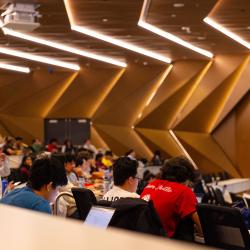Conference to Honor Mathematics Professor William “Bill” Goldman
University of Maryland Mathematics Professor William “Bill” Goldman will receive one gift for his 60th birthday that cannot be covered in wrapping paper and bows: a conference.
The UMD Department of Mathematics will host a conference June 22-24, 2016, called “Geometries, surfaces and representations of fundamental groups” in honor of Goldman’s 60th birthday, which was November 17, 2015.
UMD Associate Professor of Mathematics Karin Melnick will speak at the event, along with 14 other presenters from the United States, Canada, the United Kingdom, France, Germany, Iran and Singapore. One of the speakers is Maryam Mirzakhani, who in 2014 became the first woman to win the Fields Medal, which is widely regarded as the equivalent of the Nobel Prize in mathematics.
Goldman’s research in the area of geometric structures on manifolds has been supported by the National Science Foundation since his 1977 undergraduate thesis project. Goldman’s research focuses on how to put geometry, or quantitative measurements, on a topological space—a loosely organized collection of points where you can distort or stretch objects but you can't tear them. In May 2016, Goldman became a Fellow of the Washington Academy of Sciences.
Goldman graduated from Princeton University with his bachelor’s degree in 1977 under advisers Bill Thurston (deceased) and Dennis Sullivan. He earned his Ph.D. from the University of California, Berkeley, in 1980 under adviser Morris Hirsch, who is now a professor emeritus at the University of California, Berkeley, and the University of Wisconsin-Madison.
Goldman’s publications have received over 1,700 citations and he has advised 29 doctoral students. Before joining UMD as an associate professor of mathematics in 1986, Goldman was an assistant and associate professor at the Massachusetts Institute of Technology.
Although he has been teaching for more than 30 years, Goldman continues to innovate in the classroom. He is currently revamping MATH/AMSC 431 “Geometry for Computer Applications", a mathematics course he teaches each fall semester to students who are primarily computer science majors. According to its description, the course “explores the use of geometry (including projective geometry) for applications in graphics, vision and robotics.”
Goldman taught MATH/AMSC 431 as a lecture course, but he is redesigning it to develop a “symbiotic relationship” between the course and UMD’s Experimental Geometry Lab (EGL). Goldman co-founded the EGL, which receives funding from the National Science Foundation, in 2000 with Richard Schwartz, a professor at Brown University. In the lab, faculty members and students use programs such as Mathematica to create software for their research and educational explorations in hyperbolic geometry.
Going forward, Goldman plans for the course to include more hands-on components that enable students to apply the geometry learned in class to computer programming projects.
“Computers are like very obedient, but not particularly imaginative, students,” said Goldman. “The complexity of communicating certain ideas to computers challenges students to view mathematics from different perspectives. Using programs to transform abstract mathematical ideas into pictures we can study is an intellectual exercise that inspires us to create new math.”
Because some students in MATH/AMSC 431 are senior undergraduates who have not completed mathematics beyond calculus and linear algebra, Goldman designed the course to be “self-contained”. Students master concepts from projective geometry—the geometry of perspective—and other areas of advanced mathematics to create action-packed video games where users can steer objects, switch perspectives, monitor virtual environments and respond to threats aimed at their avatars.
While challenging for many students due to the volume and nature of the mathematics covered, the course provides students with many opportunities to apply mathematics in ways that most interest them.
“My role is to provide the mathematical inspiration and expertise to students, who then steer their projects in their own directions,” said Goldman.
At community outreach events held at local high schools, Goldman shows students pictures from the EGL to encourage their interest in geometry and other mathematics.
Labs similar to the EGL, each with a different flavor and emphasis, have popped up at other universities. Sean Lawton (B.S. ’00, M.A. ’03, Ph.D. ’06, mathematics), who worked in the EGL as a graduate student and postdoc, founded two labs: one at the University of Texas-Pan American and a second at George Mason University where he is an associate professor of mathematical sciences.
When Anton Lukyanenko (B.S. ’07, M.A. ’08, mathematics) was a graduate student at the University of Illinois at Urbana-Champaign (UIUC), he and Jayadev Athreya, a former assistant professor at UIUC and current associate professor at the University of Washington, established the Illinois Geometry Lab. Lukyanenko is currently a post-doctoral assistant professor of mathematics at the University of Michigan.
Goldman, Lawton, Lukyanenko and Athreya lead Geometry Labs United (GLU). According to Goldman, GLU allows universities with geometry labs to share different ideas and software techniques. Additionally, this organization helps universities learn how to launch new labs.
When Goldman received UMD’s 2007-2008 Distinguished Scholar-Teacher Award, an honor bestowed on a few faculty members each year in recognition of their success in scholarship and teaching, he gave a public lecture on how math is simultaneously an art, a science and a language. The EGL student projects embody this philosophy, according to Goldman.
“Many of the final outcomes are visually beautiful in themselves, sometimes due to their dramatic symmetry. The projects involve some elementary programming, but most of the intellectual depth is due to the advanced mathematics that we teach in the course,” said Goldman. “I strongly encourage students to explain in detail what is going on in the programs—through comments in the code, written documentation and presentations—because communication of abstract ideas is a very important skill for them to learn.”
Writer: Rachel Crowell







